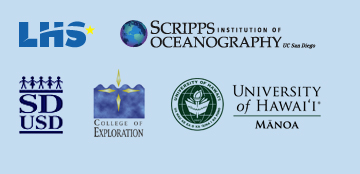The Ocean Literacy Framework is integral to the Ocean Literacy Campaign, which is a primary initiative of COSEE California. The Framework provides formal and informal educators and curriculum and program developers with a “roadmap” that helps them build coherent and conceptually sound learning experiences for students from Kindergarten through 12th grade.
The Ocean Literacy Framework
The Ocean Literacy Framework is comprised of two consensus documents:
- Ocean Literacy: The Essential Principles of Ocean Sciences K-12 (also known as the Ocean Literacy Principles)
- Ocean Literacy Scope and Sequence for Grades K-12 (also known as the Scope & Sequence).
There are seven Ocean Literacy principles and the complementary Scope and Sequence is comprised of 28 conceptual flow diagrams.
Ocean Literacy: The Essential Principles of Ocean Sciences K-12
The Ocean Literacy principles remain a work in progress; they reflect our efforts to date defining ocean literacy.
- Ocean Literacy Principle #1: The Earth has one big ocean with many features.
- Ocean Literacy Principle #2: The ocean and life in the ocean shape the features of Earth.
- Ocean Literacy Principle #3: The ocean is a major influence on weather and climate.
- Ocean Literacy Principle #4: The ocean makes the Earth habitable.
- Ocean Literacy Principle #5: The ocean supports a great diversity of life and ecosystems.
- Ocean Literacy Principle #6: The ocean and humans are inextricably interconnected.
- Ocean Literacy Principle #7: The ocean is largely unexplored.
Ocean Literacy Scope and Sequence for Grades K-12
The Scope and Sequence is an instructional tool that shows how educators can help learners build their understanding of the seven Ocean Literacy Principles throughout grades K–12.
- Conceptual flow diagrams are used as the graphical illustrations of this progression of understanding and instruction.
- There are 28 conceptual flow diagrams in the Ocean Literacy Scope and Sequence; there is one conceptual flow for each grade band (K–2, 3–5, 6–8, and 9–12) for each principle.
- The Scope and Sequence shows, graphically,
- the science concepts underlying the Principles and how they are connected;
- developmental appropriateness – what students need to know to help them understand the higher-level concepts; and
- how instruction of the concepts might “flow”.
Making the Framework, a community effort
Making the Framework has been a massive collaborative and iterative undertaking that has involved hundreds of dedicated scientists and educators working together and generously giving their time, energy, and expertise.
- This Framework is the first to identify, articulate, and organize the core concepts of ocean sciences for educational purposes. It has become a powerful rallying point for elevating the prominence of ocean sciences in the mainstream K-12 and informal science education systems.
- While it is not new for educators and scientists to work together on a project, the process of continued collaboration and partnership between educators and scientists in different agencies and organizations is significant, and has added to the potency of the Ocean Literacy Campaign.
Impacts of the Framework
The Ocean Literacy Framework has been a groundbreaking set of documents, both as a product and because of its development process. The Ocean Literacy Principles, in particular, is creating a ripple effect across the entire ocean literacy community. These ripples so far include, but are not limited to:
- A textbook and curriculum (e.g., Life on an Ocean Planet by Current Publishing and NMEA; Ocean Sciences Curriculum Sequence for Grades 3-5 by the Lawrence Hall of Science, funded by NOAA);
- Foundation for programs and exhibits at informal science education institutions (e.g., Smithsonian Sant Ocean Hall; Aquarium of the Pacific);
- A requirement in at least three grant programs in two large federal agencies (NOAA; NSF);
- Exclusive focus of national and international conferences;
- Inspiration for children’s music (the Banana Slug String Band); and
- Catalyst & model scientists and educators in other disciplines of science to identify, articulate, and organize the critical ideas of their respective fields into consensus documents. So far, these include:
Learn more.
Visit the Ocean Literacy website to find out:
|


